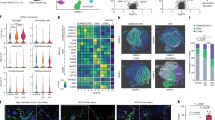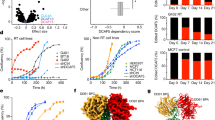Abstract
Huntington's disease is caused by expanded CAG repeats in HTT, conferring toxic gain of function on mutant HTT (mHTT) protein. Reducing mHTT amounts is postulated as a strategy for therapeutic intervention. We conducted genome-wide RNA interference screens for genes modifying mHTT abundance and identified 13 hits. We tested 10 in vivo in a Drosophila melanogaster Huntington's disease model, and 6 exhibited activity consistent with the in vitro screening results. Among these, negative regulator of ubiquitin-like protein 1 (NUB1) overexpression lowered mHTT in neuronal models and rescued mHTT-induced death. NUB1 reduces mHTT amounts by enhancing polyubiquitination and proteasomal degradation of mHTT protein. The process requires CUL3 and the ubiquitin-like protein NEDD8 necessary for CUL3 activation. As a potential approach to modulating NUB1 for treatment, interferon-β lowered mHTT and rescued neuronal toxicity through induction of NUB1. Thus, we have identified genes modifying endogenous mHTT using high-throughput screening and demonstrate NUB1 as an exemplar entry point for therapeutic intervention of Huntington's disease.
This is a preview of subscription content, access via your institution
Access options
Subscribe to this journal
Receive 12 print issues and online access
$209.00 per year
only $17.42 per issue
Buy this article
- Purchase on Springer Link
- Instant access to full article PDF
Prices may be subject to local taxes which are calculated during checkout








Similar content being viewed by others
References
The Huntington's Disease Collaborative Research Group.. A novel gene containing a trinucleotide repeat that is expanded and unstable on Huntington's disease chromosomes. Cell 72, 971–983 (1993).
Cattaneo, E., Zuccato, C. & Tartari, M. Normal huntingtin function: an alternative approach to Huntington's disease. Nat. Rev. Neurosci. 6, 919–930 (2005).
Rubinsztein, D.C. & Carmichael, J. Huntington's disease: molecular basis of neurodegeneration. Expert Rev. Mol. Med. 5, 1–21 (2003).
Walker, F.O. Huntington's disease. Lancet 369, 218–228 (2007).
Landles, C. et al. Proteolysis of mutant huntingtin produces an exon 1 fragment that accumulates as an aggregated protein in neuronal nuclei in Huntington disease. J. Biol. Chem. 285, 8808–8823 (2010).
Nagashima, Y., Kowa, H., Tsuji, S. & Iwata, A. FAT10 protein binds to polyglutamine proteins and modulates their solubility. J. Biol. Chem. 286, 29594–29600 (2011).
Subramaniam, S., Sixt, K.M., Barrow, R. & Snyder, S.H. Rhes, a striatal specific protein, mediates mutant-huntingtin cytotoxicity. Science 324, 1327–1330 (2009).
Thompson, L.M. et al. IKK phosphorylates Huntingtin and targets it for degradation by the proteasome and lysosome. J. Cell Biol. 187, 1083–1099 (2009).
Yamamoto, A., Lucas, J.J. & Hen, R. Reversal of neuropathology and motor dysfunction in a conditional model of Huntington's disease. Cell 101, 57–66 (2000).
DiFiglia, M. et al. Therapeutic silencing of mutant huntingtin with siRNA attenuates striatal and cortical neuropathology and behavioral deficits. Proc. Natl. Acad. Sci. USA 104, 17204–17209 (2007).
Harper, S.Q. et al. RNA interference improves motor and neuropathological abnormalities in a Huntington's disease mouse model. Proc. Natl. Acad. Sci. USA 102, 5820–5825 (2005).
Rodriguez-Lebron, E., Denovan-Wright, E.M., Nash, K., Lewin, A.S. & Mandel, R.J. Intrastriatal rAAV-mediated delivery of anti-huntingtin shRNAs induces partial reversal of disease progression in R6/1 Huntington's disease transgenic mice. Mol. Ther. 12, 618–633 (2005).
Boudreau, R.L. et al. Nonallele-specific silencing of mutant and wild-type huntingtin demonstrates therapeutic efficacy in Huntington's disease mice. Mol. Ther. 17, 1053–1063 (2009).
Drouet, V. et al. Sustained effects of nonallele-specific Huntingtin silencing. Ann. Neurol. 65, 276–285 (2009).
Bauer, P.O. et al. Harnessing chaperone-mediated autophagy for the selective degradation of mutant huntingtin protein. Nat. Biotechnol. 28, 256–263 (2010).
Sarkar, S., Ravikumar, B., Floto, R.A. & Rubinsztein, D.C. Rapamycin and mTOR-independent autophagy inducers ameliorate toxicity of polyglutamine-expanded huntingtin and related proteinopathies. Cell Death Differ. 16, 46–56 (2009).
Filimonenko, M. et al. The selective macroautophagic degradation of aggregated proteins requires the PI3P-binding protein Alfy. Mol. Cell 38, 265–279 (2010).
Jana, N.R. et al. Co-chaperone CHIP associates with expanded polyglutamine protein and promotes their degradation by proteasomes. J. Biol. Chem. 280, 11635–11640 (2005).
Kaltenbach, L.S. et al. Huntingtin interacting proteins are genetic modifiers of neurodegeneration. PLoS Genet. 3, e82 (2007).
Shirasaki, D.I. et al. Network organization of the huntingtin proteomic interactome in mammalian brain. Neuron 75, 41–57 (2012).
Doumanis, J., Wada, K., Kino, Y., Moore, A.W. & Nukina, N. RNAi screening in Drosophila cells identifies new modifiers of mutant huntingtin aggregation. PLoS ONE 4, e7275 (2009).
Zhang, S., Binari, R., Zhou, R. & Perrimon, N. A genomewide RNA interference screen for modifiers of aggregates formation by mutant Huntingtin in Drosophila. Genetics 184, 1165–1179 (2010).
Miller, J.P. et al. Matrix metalloproteinases are modifiers of huntingtin proteolysis and toxicity in Huntington's disease. Neuron 67, 199–212 (2010).
Bauer, P.O. & Nukina, N. Enhanced degradation of mutant huntingtin by rho kinase inhibition is mediated through activation of proteasome and macroautophagy. Autophagy 5, 747–748 (2009).
Brand, A.H. & Perrimon, N. Targeted gene expression as a means of altering cell fates and generating dominant phenotypes. Development 118, 401–415 (1993).
Tanji, K. et al. NUB1 suppresses the formation of Lewy body-like inclusions by proteasomal degradation of synphilin-1. Am. J. Pathol. 169, 553–565 (2006).
Kito, K., Yeh, E.T. & Kamitani, T. NUB1, a NEDD8-interacting protein, is induced by interferon and down-regulates the NEDD8 expression. J. Biol. Chem. 276, 20603–20609 (2001).
Baldo, B. et al. TR-FRET-based duplex immunoassay reveals an inverse correlation of soluble and aggregated mutant huntingtin in Huntington's disease. Chem. Biol. 19, 264–275 (2012).
Gutekunst, C.A. et al. Nuclear and neuropil aggregates in Huntington's disease: relationship to neuropathology. J. Neurosci. 19, 2522–2534 (1999).
Lu, B. & Palacino, J. A novel human embryonic stem cell-derived Huntington's disease neuronal model exhibits mutant huntingtin (mHTT) aggregates and soluble mHTT-dependent neurodegeneration. FASEB J . doi:10.1096/fj.12-219220 (16 January 2013).
The HD iPSC Consortium. Induced pluripotent stem cells from patients with Huntington's disease show CAG-repeat-expansion-associated phenotypes. Cell Stem Cell 11, 264–278 (2012).
Kamitani, T., Kito, K., Fukuda-Kamitani, T. & Yeh, E.T. Targeting of NEDD8 and its conjugates for proteasomal degradation by NUB1. J. Biol. Chem. 276, 46655–46660 (2001).
Tanaka, T., Kawashima, H., Yeh, E.T. & Kamitani, T. Regulation of the NEDD8 conjugation system by a splicing variant, NUB1L. J. Biol. Chem. 278, 32905–32913 (2003).
Hipp, M.S., Raasi, S., Groettrup, M. & Schmidtke, G. NEDD8 ultimate buster-1L interacts with the ubiquitin-like protein FAT10 and accelerates its degradation. J. Biol. Chem. 279, 16503–16510 (2004).
Soucy, T.A. et al. An inhibitor of NEDD8-activating enzyme as a new approach to treat cancer. Nature 458, 732–736 (2009).
Chew, E.H. & Hagen, T. Substrate-mediated regulation of cullin neddylation. J. Biol. Chem. 282, 17032–17040 (2007).
Paty, D.W., Li, D.K. & the UBC MS/MRI Study Group & the IFNB Multiple Sclerosis Study Group. Interferon beta-1b is effective in relapsing-remitting multiple sclerosis. II. MRI analysis results of a multicenter, randomized, double-blind, placebo-controlled trial. Neurology 43, 662–667 (1993).
MacDonald, M.E. et al. Targeted inactivation of the mouse Huntington's disease gene homolog Hdh. Cold Spring Harb. Symp. Quant. Biol. 61, 627–638 (1996).
Duyao, M.P. et al. Inactivation of the mouse Huntington's disease gene homolog Hdh. Science 269, 407–410 (1995).
Grondin, R. et al. Six-month partial suppression of Huntingtin is well tolerated in the adult rhesus striatum. Brain 135, 1197–1209 (2012).
Tanji, K. et al. Immunohistochemical localization of NUB1, a synphilin-1-binding protein, in neurodegenerative disorders. Acta Neuropathol. 114, 365–371 (2007).
Weiss, A., Roscic, A. & Paganetti, P. Inducible mutant huntingtin expression in HN10 cells reproduces Huntington's disease-like neuronal dysfunction. Mol. Neurodegener. 4, 11 (2009).
Lacoste, A., Berenshteyn, F. & Brivanlou, A.H. An efficient and reversible transposable system for gene delivery and lineage-specific differentiation in human embryonic stem cells. Cell Stem Cell 5, 332–342 (2009).
Chambers, S.M. et al. Highly efficient neural conversion of human ES and iPS cells by dual inhibition of SMAD signaling. Nat. Biotechnol. 27, 275–280 (2009).
Ko, J., Ou, S. & Patterson, P.H. New anti-huntingtin monoclonal antibodies: implications for huntingtin conformation and its binding proteins. Brain Res. Bull. 56, 319–329 (2001).
Weiss, A. et al. Single-step detection of mutant huntingtin in animal and human tissues: a bioassay for Huntington's disease. Anal. Biochem. 395, 8–15 (2009).
Weiss, A. et al. Mutant huntingtin fragmentation in immune cells tracks Huntington's disease progression. J. Clin. Invest. 122, 3731–3736 (2012).
Al-Ramahi, I. et al. CHIP protects from the neurotoxicity of expanded and wild-type ataxin-1 and promotes their ubiquitination and degradation. J. Biol. Chem. 281, 26714–26724 (2006).
Menalled, L.B., Sison, J.D., Dragatsis, I., Zeitlin, S. & Chesselet, M.F. Time course of early motor and neuropathological anomalies in a knock-in mouse model of Huntington's disease with 140 CAG repeats. J. Comp. Neurol. 465, 11–26 (2003).
Valencia, A. et al. Mutant huntingtin and glycogen synthase kinase 3-beta accumulate in neuronal lipid rafts of a presymptomatic knock-in mouse model of Huntington's disease. J. Neurosci. Res. 88, 179–190 (2010).
Liew, C.W. et al. The pseudokinase tribbles homolog 3 interacts with ATF4 to negatively regulate insulin exocytosis in human and mouse beta cells. J. Clin. Invest. 120, 2876–2888 (2010).
Acknowledgements
The authors wish to thank D. Curtis for discussions and suggestions during the project, X. Shi for performing the control screening on SMN level changes, C. Mazur for assistance with cloning and sample processing, P. Manos and C. Littlefield for assistance with the hESC and human iPSC experiments, and E. Kim for assistance with the fly experiments. I.A. was funded by a John J. Wasmuth postdoctoral fellowship from the Hereditary Disease Foundation. A.V. was funded by the Hereditary Disease Foundation. M.D. was funded by US National Institutes of Health grant NS074381.
Author information
Authors and Affiliations
Contributions
B.L. and J.P. initiated the project and designed the experiments; B.L. and H.Y. carried out the primary S2 screen (Fig. 1); B.L. and Q.W. carried out the validation screen in human patient fibroblasts (Fig. 2); B.L., M.H. and J.P. analyzed the screen data; I.A.-R., T.G.-F. and J.B. performed in vivo experiments in the fly (Figs. 3 and 4); A.V. and M.D. did the rescue experiments in neurons (Figs. 5d and 8e); S.I. did the quantitative PCR for Nedd8 and FAT10 in HN10 cells (Supplementary Fig. 7); A.L. generated the human iPSC lines; F.B. and A.L. differentiated hESCs and iPSCs into neurons; B.L. performed all other experiments; B.L. and J.P. wrote the manuscript.
Corresponding authors
Ethics declarations
Competing interests
The authors declare no competing financial interests.
Supplementary information
Supplementary Text and Figures
Supplementary Figures 1–9 (PDF 12214 kb)
Rights and permissions
About this article
Cite this article
Lu, B., Al-Ramahi, I., Valencia, A. et al. Identification of NUB1 as a suppressor of mutant Huntingtin toxicity via enhanced protein clearance. Nat Neurosci 16, 562–570 (2013). https://doi.org/10.1038/nn.3367
Received:
Accepted:
Published:
Issue Date:
DOI: https://doi.org/10.1038/nn.3367
This article is cited by
-
The Emerging Roles of E3 Ligases and DUBs in Neurodegenerative Diseases
Molecular Neurobiology (2023)
-
Modifier pathways in polyglutamine (PolyQ) diseases: from genetic screens to drug targets
Cellular and Molecular Life Sciences (2022)
-
Tau Accumulation via Reduced Autophagy Mediates GGGGCC Repeat Expansion-Induced Neurodegeneration in Drosophila Model of ALS
Neuroscience Bulletin (2020)
-
Allele-selective lowering of mutant HTT protein by HTT–LC3 linker compounds
Nature (2019)
-
Quality Control in Huntington’s Disease: a Therapeutic Target
Neurotoxicity Research (2019)



